Tanzanite
A popular blue gem that is only produced commercially in one small area of Tanzania.
Author: Hobart M. King, PhD, GIA Graduate Gemologist
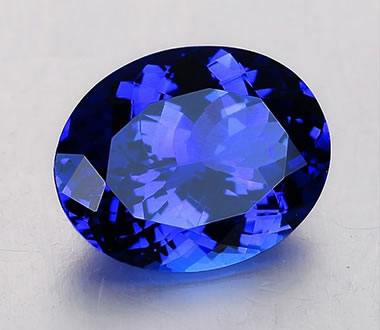
Faceted blue tanzanite: This violetish blue tanzanite is an exceptional faceted oval weighing 8.14 carats and measuring 14.4 x 10.5 x 7.6 millimeters in size. On the basis of its color and clarity, it would be rated in the top 1% of all tanzanite ever produced. It is easy to see why Tiffany's called tanzanite "the most beautiful blue stone to be discovered in 2000 years." Stones of this quality might be purchased by museums, investors, or collectors, or used in custom or designer jewelry. Photo copyright by Tanzanite Direct and displayed here with permission.
What is Tanzanite?
Tanzanite is a trade name that was first used by Tiffany and Company for gem-quality specimens of a mineral named zoisite with a blue color. Tiffany could have sold the material under the mineralogical name of "blue zoisite," but they thought the name "tanzanite" would stimulate customer interest and be easier to market.
The name "tanzanite" was given because the world's only known tanzanite deposit of commercial importance is in northern Tanzania. The name reflects the gem’s limited geographic origin. The mines are all located in an area of about eight square miles in the Merelani Hills, near the base of Mount Kilimanjaro and the city of Arusha.
Table of Contents
A Modern Gem and Birthstone
Although nearly all of the world’s most popular gemstones have been known and used for hundreds of years, tanzanite was not discovered in commercial quantities until the 1960s. In the short time since then, it has become the second most popular blue gem after sapphire.
It is one of a very small number of gems of any color that have been discovered and brought to strong consumer popularity within the past century. This rapid rise to popularity was accomplished mainly by Tiffany's promotion and tanzanite's beautiful blue color. Because of its growing popularity, Tanzanite was designated as a modern birthstone for the month of December in 2002.
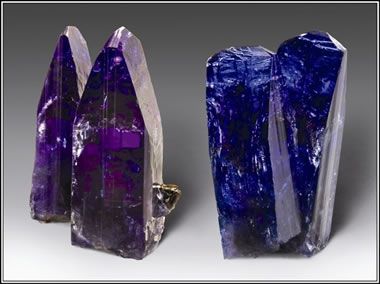
Natural blue tanzanite: The pair of crystals shown on the left is the same pair of crystals shown on the right. They have different apparent colors because tanzanite is pleochroic - it appears to be different colors when viewed from different directions.
If we cut a faceted stone from the crystal pair on the right and oriented the cutting so that, in this view, we were looking down onto the top of the table, the stone would have a blue face-up color. If we did the same with the crystal pair on the left, the stone would have a purple face-up color. If the table of the stone were tilted slightly in any direction, an intermediate face-up color would be produced.
This pair of crystals has not been heated by humans. Their colors are natural. It is an example of tanzanite having spectacular natural color. Specimen and photo by Arkenstone / www.iRocks.com.
Tanzanite's Interesting Color
The mineral zoisite naturally occurs in a wide range of colors that include colorless, gray, yellow, brown, pink, green, blue, and violet. The name "tanzanite" is used for a color variety of zoisite that ranges from blue, through violet, to violetish purple.
This type of color-variety name is not unusual. The name "ruby" is used for red to slightly purplish red specimens of the mineral corundum; the name "amethyst" is used for purple specimens of the mineral quartz; and, the name "emerald" is used for green specimens of the mineral beryl. Each of these minerals occurs in a wide range of other colors.
The discovery of transparent crystals of blue zoisite in the 1960s stimulated interest in the gem. Soon after that discovery, laboratory experiments determined that heating could improve the color of some naturally blue stones.
They also determined that heating could convert some naturally brown or green zoisite into beautiful blue zoisite (tanzanite!). With those discoveries, there would be enough tanzanite to support a marketing effort that would introduce the gem to millions of people.
What Causes Tanzanite's Color?
The blue color of tanzanite is caused by small amounts of vanadium within the zoisite mineral structure. When vanadium-bearing zoisite is heated to a temperature of 600 degrees Celsius for about 30 minutes, the oxidation state of the vanadium is changed and that change causes or improves the blue color.
The heat treatment of tanzanite is very mild when compared to what is often done for gems such as rubies and sapphires. Those gems can be heated to temperatures between 1000 and 1800 degrees Celsius and held at those temperatures for days or weeks.
Today, nearly all of the gems being sold as "tanzanite" have a blue color that has been produced or enhanced by heating. A small amount of tanzanite in the marketplace has a blue color that was produced naturally through the heat of metamorphism without any treatment by people. This naturally blue, untreated tanzanite, is held in very high regard by some gemstone and jewelry buyers who seek it out when making a purchase.

Tanzanite colors: The tanzanite gems in these rings show a range of blue color that can be found in tanzanite. Most buyers prefer stones with a strong-to-vivid blue color like the ones in the top row of this image. These stones sell for a much higher price than stones with a lighter color. However, many people prefer the lighter-color gems and gladly pay their lower price. Tanzanite has a range of blue colors that place it in competition with sapphire, blue topaz, and aquamarine. Photo copyright by Tanzanite Direct and displayed here with permission.
Tanzanite Among Other Blue Gems
The four blue faceted gemstones that are most often seen in commercial jewelry in the United States are aquamarine, topaz, sapphire, and tanzanite. Although they are all "blue" in color, each one is unique.
Tanzanite occurs in a range of tones and color saturations that will appeal to almost any buyer who likes any of the other blue gems. The four rings in the accompanying image contain tanzanite gems that range in color from a vivid blue at top left to a very light blue at lower right.
Tanzanite gems with a strong-to-vivid blue, purplish blue and violetish blue color are the most valuable. The two rings at the top of the image are examples. These rich colors are the most appealing to the majority of people shopping for tanzanite.
Most tanzanite has a light to medium tone and low to medium saturation. The two tanzanite rings at the bottom of the image are examples. Although these gems are not considered to be top color, many people prefer them and gladly pay their lower price. Tanzanite in these softer colors often appeals to buyers who like aquamarine and blue topaz.
Tanzanite stands out in mall and chain store jewelry displays because many stones have a distinct hint of purple or violet in their color. People who have experience looking at gems and pay attention to color can often notice tanzanite in a display case of blue gems.
Tanzanite and sapphire are the two favorite blue stones in the gem marketplace. Tanzanite is a gem that many people desire because of its unique beauty and characteristics. Others purchase tanzanite because it has a beauty similar to sapphire, usually at a much lower price.
Tanzanite also competes with lab-created sapphires that are lower in price than natural sapphires. In that comparison, some buyers will select tanzanite because they would rather have a stone that was created by nature instead of one created in a lab.
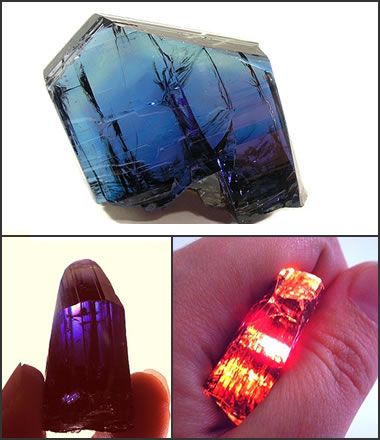
Pleochroism in tanzanite: These three photos show the same crystal of tanzanite viewed from three different crystallographic directions. They display the pleochroic properties of the gem. Pleochroism occurs when a gem appears to be different colors when viewed from different crystallographic directions. This specimen is trichroic - it appears to be different colors from three different directions. Looking at the broad side of the crystal, the gem has a wonderful blue color. When viewed from the narrow side, the specimen is deep violet. And, when viewed down the vertical axis with illumination below, it exhibits a reddish color. Those are the three pleochroic colors and three crystallographic directions for this specimen. This specimen has not been heated. Heating could strengthen the blue color and reduce the pleochroic effect. Specimen and photos by Arkenstone / www.iRocks.com.
Pleochroism in Tanzanite
Tanzanite is a pleochroic gem. Pleochroism is a physical property in which the material appears to be different colors when viewed from different crystallographic directions. Some specimens of tanzanite can be a distinct blue when viewed from one direction, and vary from violet to reddish when viewed from other directions.
The group of three photos on this page shows a tanzanite crystal viewed from three different crystallographic directions. Because each of the three directions exhibits a different color, this makes tanzanite a "trichroic" material.
Pleochroism complicates the cutting process of tanzanite but also presents opportunity. The color of a finished stone will vary depending upon how the table of the stone intersects the crystallographic axes within the rough.
The top color for tanzanite is a vivid blue. Cutters must examine each piece of rough and determine if they can cut it in an orientation that will yield a finished stone with maximum face-up blue color. If that is possible, they then determine if changing the orientation of the cut will yield a larger stone of second-quality color that will sell for a higher price.
Deciding how to cut tanzanite is an exercise in skill, knowledge, and price estimation. In the cutting of tanzanite, some of the most highly skilled employees examine the rough and plan how it will be cut to maximize color or value. The stone is then cut into a preliminary shape - known as a preform. That is the step where value is gained or lost. It must be done carefully and with a high level of skill for every important stone.
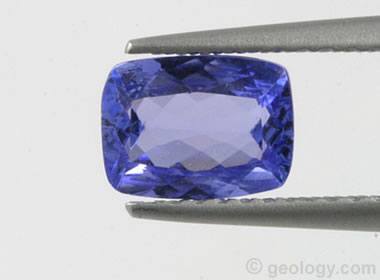
Tanzanite gem: A violet-blue tanzanite measuring 7 x 5 x 3 millimeters in size and weighing 1.02 carats, antique facet cut. This grade of tanzanite is often seen in mall and chain store jewelry. The stone in the photo at the top of this page might be seen in exclusive jewelry stores or in showings of designer or custom jewelry items.
How Large are Tanzanite Gems?
Tanzanite is like all other gems in that small stones are more abundant than larger stones. Most faceted tanzanites are under five carats in weight. Stones over fifty carats are very rare.
Small stones are typically cut into calibrated sizes for use in commercial jewelry. Those with top-grade color are the most valuable and often go into custom or designer jewelry.
Large stones with exceptional color are very rare. These are often purchased by collectors, museums, or investors. Some are also used to make special pieces of custom or designer jewelry.
The size of a tanzanite gem influences its color. If you have two stones of equal saturation, the larger stone will have a richer apparent color - because the distance that light travels through the stone has an influence on its perceived color.
Physical Properties of Tanzanite |
|
| Mineralogy | Tanzanite is a blue color-variety of the mineral zoisite. |
| Color | Blue to bluish purple to bluish violet. The color of commercial stones is almost always produced or enhanced by heating brown or green zoisite. Strong pleochroism: dichroism and trichroism. Tanzanite is seen in a wide range of color saturations and tones that make it an alternative stone for aquamarine, blue topaz, and sapphire. |
| Luster | Vitreous |
| Diaphaneity | Transparent. Often of high clarity. |
| Cleavage / Fracture | Perfect cleavage in one direction. |
| Mohs Hardness | 6.5 |
| Specific Gravity | 3.35 |
| Diagnostic Properties | Defined by its blue color, usually with a distinct purple or violet tint. Strong pleochroism, specific gravity, hardness, refractive index. |
| Chemical Composition | Ca2Al3(SiO4)3(OH) |
| Crystal System | Orthorhombic |
| Uses | Gemstone |
Durability of Tanzanite
Tanzanite is a beautiful gem. In addition to its beauty, it has some properties that require it to be given special care. Tanzanite is best suited for earrings, pendants, and other jewelry items that will not encounter abrasion and impact. It is less suited for use in a ring. Many jewelers recommend that "tanzanite rings are for dress rather than daily wear."
Hardness is the resistance of a gem to being scratched. Tanzanite has a hardness of about 6.5 on the Mohs Hardness Scale. This hardness is low enough that the gem is vulnerable to being scratched during normal wear if it is used in a ring. This problem can be reduced if the setting is designed to protect the stone from impact and abrasion, or if the ring is not worn during activities when the chance of impact or abrasion is high.
Toughness is the resistance of a gem to breakage. Tanzanite has one direction of perfect cleavage that could result in the gem being chipped or broken if it receives a sharp impact. Again, settings can be designed to protect the stone, and the owner can avoid wearing the piece during certain activities to reduce the probability of damage. Tanzanite is also sensitive to sudden temperature change and is more subject to breakage at that time.
Color stability in tanzanite is good. Heat-treated stones hold their color and are unlikely to fade under the normal light exposure and in the temperature range of the human environment. As with all gems, contact with acids and other chemicals should be avoided because the stone might be etched or damaged. If cleaning is needed, warm water and a mild soap are recommended. Steam and ultrasonic cleaning are not recommended.
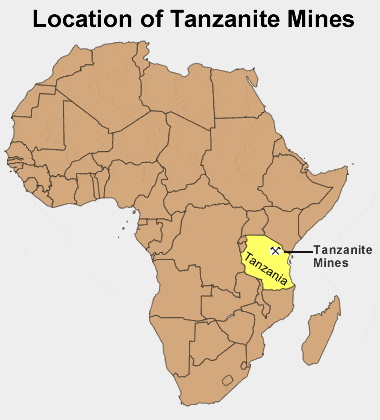
Tanzanite map: This map shows the location in northern Tanzania where all of the world's known commercial tanzanite production occurs.
Teach the World about Tanzanite
In 1967, when the first tanzanite had been faceted and prepared for the market, jewelers and the public knew nothing of the gem. They had never seen its blue color or heard its name. To introduce the world to tanzanite, Tiffany and Company launched a public education program.
Tiffany prepared educational materials that would make consumers aware of the gem, and they prepared materials to help jewelers understand it, market it, and explain its characteristics to their customers. When a new, previously unknown gemstone enters the market, every person who sells and buys must be educated before transactions can occur.
More recently, in 2003, TanzaniteOne Mining Ltd, the leading miner of tanzanite, and a company that cuts, manufactures, wholesales and retails tanzanite gems and jewelry, established The Tanzanite Foundation, a non-profit organization that promotes tanzanite. The Foundation prepares educational materials for retailers and consumers, assists with retail staff training, and assists retailers with tanzanite promotion. The Foundation is also a participant in the Tucson Tanzanite Protocol, an organization that works to ensure that tanzanite has an ethical route to market, similar to how the Kimberley Process works to prevent conflict diamonds from entering the diamond market.
Tanzanite Price Stability
The price history of tanzanite has seen many sharp rises and falls. These price changes have been related to the limited number of mines and the limited geographic location of the world’s tanzanite resource. Decisions and regulations of the Tanzanian government can have an immediate impact on the availability and price of the entire world's supply.
Tanzanite does not have the price insulation enjoyed by gems that are mined in multiple countries and on different continents. Events such as floods or mining challenges also have an immediate impact upon supply and price.
Illegal mining and smuggling have also moved the price of tanzanite. In 2012 and 2013 large numbers of illegal miners entered the tanzanite mining areas and began to aggressively mine the easy-to-access areas. This occurred at a height of tanzanite prices. They then dumped a flood of illegal production into the market, causing a sharp decline in tanzanite prices during the following two years.
When prices change, commercial-grade gems usually experience the greatest price instability. These are the most abundant grades of tanzanite where price competition is highest. Top-quality stones, especially those in larger sizes, are very rare. As a general rule, they tend to retain their value in down markets and increase in value in rising markets.
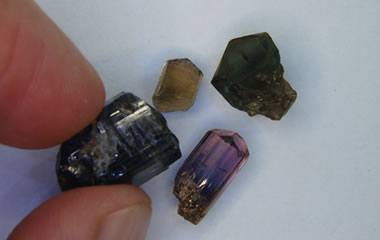
Tanzanite before heating: Tanzanite in the rough state, before heat treatment. Note that the colors are brownish and unlike the vivid blues that are seen in finished jewelry. Inexperienced people in the field might not notice this material. Photo courtesy of The Rare Gemstone Company.
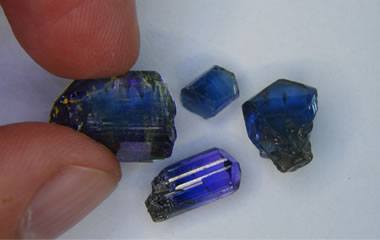
Heat-treated tanzanite: Tanzanite after heat treatment at 600 degrees centigrade. Note how the color has changed to a vivid blue. Photo courtesy of The Rare Gemstone Company.
Treated, Synthetic, Imitation
Heat-Treated Tanaznite
Heat treatment is done to almost all of the tanzanite on the market today. With the exception of a small amount of naturally blue material, heating is the source of tanzanite's desirable blue color. This treatment is widely known and should be expected by retailers and customers.
A small amount of untreated tanzanite with an excellent color is found in the mines. This naturally blue material is preferred by some buyers. An article on The Rare Gemstone Company's website has good photos of tanzanite before and after treatment and explains why the color change occurs. [4]
Synthetic Tanzanite
Synthetic tanzanite is not known in the marketplace. When this article was last updated in late 2019, a literature review did not indicate that anyone had successfully produced and marketed synthetic tanzanite. However, stones are being offered for sale as "synthetic tanzanite". These are really imitation tanzanite being sold by sellers who are not using the proper terminology. As with any other gem, sellers of synthetic or imitation gems are obligated to clearly disclose their man-made origin at the time of sale - just as is done for lab-created diamonds, rubies, emeralds, and many other gems.
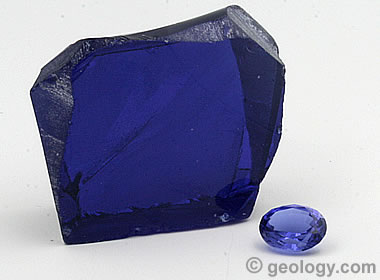
Tanzanite imitations: A variety of man-made materials are used to simulate tanzanite. Shown here are a piece of Nanosital rough and a faceted stone. Nanosital is a Russian glass-ceramic that is made in a variety of gemstone look-alike colors. Nanosital is easily separated from the stones that it imitates with standard gemological tests.
Imitation Tanzanite
Imitations exist for every popular gem, and tanzanite is no exception. A few manufactured materials have a similar appearance to tanzanite. A synthetic forsterite (a mineral in the olivine solid solution series) is being produced with a color and pleochroism that resembles tanzanite.
Coranite is a synthetic blue corundum that resembles tanzanite. Tanavyte is a purple yttrium aluminum garnet that resembles tanzanite. Some blue glass has also been used as a tanzanite imitation.
Nanosital is a man-made glass-ceramic that is manufactured in a variety of gemstone look-alike colors. One of these is a bluish-violet material sold as a tanzanite simulant. It can easily be separated from natural tanzanite using a polariscope because tanzanite is doubly refractive while nanosital is singly refractive. Using a spectroscope, nanosital displays a spectacular spectrum, with numerous weak lines in the blue; a weak line and a strong broad band in the green; a very strong broad band near the yellow-orange boundary; and a broad weak band and a weak line in the red. Tanzanite might show bands at 455, 528 and 595. Another obvious test is pleochroism, tanzanite is spectacularly trichroic, while nanosital is not pleochroic.
Imitation materials cannot legally be sold as "tanzanite." They must be labeled in a way that gives the buyer a clear understanding that the item being purchased is not natural tanzanite - it only "looks like tanzanite."
Coated Tanzanite
Coatings of cobalt have been applied to some pale-colored tanzanites to improve their color. These treatments can be recognized by experienced jewelers and should be disclosed to the buyer. As always, buying from a reputable jeweler is the way to purchase with confidence.
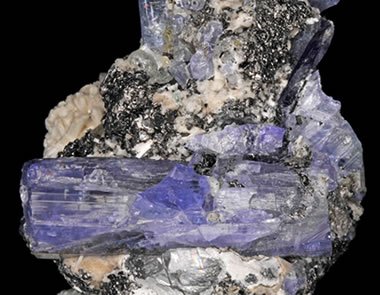
Tanzanite with graphite and laumontite: Crystals of blue tanzanite in a rock matrix with graphite and laumontite. Specimen is from Merelani Hills, Tanzania. Photograph by Parent Géry, displayed here under a Creative Commons license.
How Much More Tanzanite?
Tanzanite is one of the best-selling colored stones in today's gem and jewelry markets. That is a surprise considering that it was only discovered in the 1960s, while all of the other best-selling colored stones have been known for centuries. It has a unique blue color that grows in popularity as more people learn about it. The popularity is expected to grow as colored stones become more common purchases in developing economies.
At the same time, tanzanite is a rare gem. All of the known deposits are confined to a few square miles of land in northern Tanzania. It is the only gemstone with a large and growing popularity that has such a limited known supply. Some people believe that the currently known tanzanite resource could be depleted in just a few decades.
A study, published in 2018 by the National Bureau of Statistics of Tanzania, estimated that the total tanzanite reserves were 109 million carats. [6] Also in 2018, the High Commission of the United Republic of Tanzania, reported that Block C, the largest block in the tanzanite mining area, accounting for over 50% of the mining area, and the only mechanized block, had estimated total reserves of about 87.1 million carats. These reserves were thought to be enough to support mining into the 2040s. [7]
These reports are for the current tanzanite mining area. They do not consider discoveries that might be made in other parts of Tanzania, or in other parts of the world.
| Tanzanite References |
|
[1] Working the Blueseam: The Tanzanite Mines of Merelani: Vincent Pardieu and Richard W. Hughes, with Guillaume Soubiraa, Michael Rogers, Warne and Montgomery Chitty and Philippe Brunot; website article published on Ruby-Sapphire.com, 2008.
[2] Tanzanite Resource Assessment: Regulatory News Service, London Stock Exchange, published on Investegate.co.uk, February 2012. [3] Gem Identification Lab Manual: Gemological Institute of America; 496 pages, 2014. [4] Tanzanite Heating - The Facts: Antony Zagoritis; website article published on TheRareGemstoneCompany.com, last accessed August 2022. [5] Advertising Diamonds, Gemstones and Pearls: Federal Trade Commission; website article published on FTC.gov, last accessed August 2022. [6] National Environment Statistics Report - Tanzania Mainland (pdf): by the National Bureau of Statistics of Tanzania, June 2018; last accessed August 2022. [7] Tanzania High Commissioner Of Tanzania Minerals And Metals Outlook, 2030: Presentation by H. E. Baraka H. Luvanda, published by the High Commission of the United Republic of Tanzania, October 2018; last accessed August 2022. |
Investing in Tanzanite?
Numerous sellers of tanzanite use the fact that tanzanite is only found in one small area to promote the material’s rarity. A counter to that is that the world is an enormous planet and zoisite is not an extremely rare mineral.
How many people and companies are out looking for samples of zoisite and taking them back to a lab to see if they will heat to a blue color? Probably very few. However, if the price skyrockets and a lot of exploration occurs, that work might discover so much "tanzanite-quality" zoisite that the price falls to historically low levels. Oil, natural gas and other commodities are not at historic high prices today because technology and exploration has identified enormous new deposits.
Some sellers also suggest that the value of tanzanite will skyrocket when the known deposits are mined out. That might occur initially. No one knows for sure. A counter is that the price might initially rise but then, when no new tanzanite is entering the market, the price will decline to low levels as the gem loses its visibility and popularity and fades in the minds of buyers.
What happens when tanzanite supplies deplete cannot be predicted. People who invest in tanzanite might make money, but profits are not guaranteed.
Disclosure: Tanzanite is one of the author's favorite gems. He owns a few faceted stones and a few pieces of rough for gemological study. He has no intentions of buying tanzanite as an investment. He would not be surprised if tanzanite was found in other parts of the world.
| More Gemstones |
 |
Tourmaline |
 |
Fancy Sapphires |
 |
Diamond |
 |
Canadian Diamond Mines |
 |
Birthstones |
 |
Pictures of Opal |
 |
Fire Agate |
 |
Blue Gemstones |

Find Other Topics on Geology.com:

|

| ||

|

| ||

|

| ||

|

|

